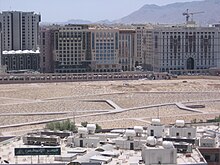Destruction of the Islamic cultural heritage in Saudi Arabia
The destruction of Islamic cultural heritage in Saudi Arabia is mainly taking place in the Saudi Arabian region of Hejaz , particularly in the holy cities of Mecca and Medina . It mainly affects old mosques, cemeteries, houses and places related to the founder of the religion Mohammed and other leading figures of early Islam . The main reasons for this destruction are the expansion works around the al-Haram Mosque in Mecca and the Prophet's Mosque in Medina, which receive an increasing number of pilgrims year after year .
According to the Islamic Heritage Research Foundation in London , the Saudi state is said to have destroyed around 98% of its historical and religious buildings between 1985 and 2014 . Not only Muslim but also pre-Islamic cultural assets were (and are) destroyed, for example after the occupation of the Grand Mosque in 1979.
history

In 1932 the process of political unification of Saudi Arabia was completed and Ibn Saud of the Saud dynasty declared himself king. From 1938, when oil production began at Dammam , Ibn Saud rose to become one of the richest rulers in the Islamic world. Due to the rich oil deposits, the kingdom achieved prosperity and an enormous importance for the economy of the western industrial nations. The Hashimites , who had ruled the Hejaz up to now , were driven out by Ibn Saud and his Bedouin army. The new rulers came from the Najd highlands and belonged to the Wahhabi school of Islam, which strictly rejects Sufism , all forms of Shia , veneration of saints and pilgrimages to graves . The traditional religious practices in the Hejaz were portrayed by Wahhabi scholars as unfounded superstitions and rigorously fought on accusations of apostasy from monotheism .
The Wahhabi movement was founded by Muhammad ibn ʿAbd al-Wahhāb in the late 18th century and began plundering and destroying Muslim shrines in the early 19th century. In 1802, Wahhabis from Najd, led by Abd al-Aziz ibn Muhammad, sacked the city of Karbala , killing thousands of residents and destroying the grave of Muhammad's grandson Hussain . In the same year, a Wahhabi army captured Ta'if , and a year later Mecca, where they destroyed the shrines in the Jannat al-Mualla cemetery above the graves of Muhammad's wife Khadijah , his daughter Fatima and other relatives. In 1806 Medina was occupied, where the al-Baqi 'cemetery next to the Prophet's Mosque was destroyed for the first time. The conflict with the Turkish protective power led to the seven-year Ottoman-Saudi War (1811-1818) in which the Ottoman army won a decisive victory, forced the Saudis to withdraw from the Hejaz and built numerous sanctuaries in the region by 1860.
On April 21, 1925, the mausoleums and shrines in the al-Baqi 'cemetery in Medina were again demolished. The graves of the victims of the battle of Uhud , including that of Muhammad's uncle Hamza ibn ʿAbd al-Muttalib , the graves of the imams Ali Zain al-Abidin , Muhammad al-Bāqir and Jafar al-Sadiq , as well as several , were particularly targeted this time Mosques related to Mohammed and his relatives. Except for two surviving lines, the famous Qasida al-Burda by al-Busiri , in which the poet from the 13th century praises the merits of Muhammad, has been painted over. In addition, the house of Mohammed's concubine Maria and the tomb of Hamīda, the mother of Mūsā al-Kāzim, were destroyed in Medina . The destruction is commemorated annually on the day of mourning (yaum-e gham) .
In the 21st century, cultural sites in Mecca and Medina are being eliminated by the Saudi authorities on an unprecedented scale, while luxury hotels, restaurants and shopping centers are being built. It is estimated that $ 13 billion is currently being spent on hotels, services, and infrastructure improvements. In the course of the construction of the billion-dollar Abraj Al Bait skyscrapers with the Mecca Royal Clock Tower Hotel , one of the world's tallest buildings , the Ottoman Adschjad fortress , built around 1780, was demolished in the spring of 2002 and most of the Bulbul Hill on which it was built stood, leveled, which was heavily criticized by the Turkish Foreign Minister İsmail Cem and other official representatives of Turkey . On the other hand, ʿAbd al-Wahhāb's place of work, Diriyya, is being expanded into a tourist attraction. The Pakistani-British scholar Ziauddin Sardar speaks of the destruction of Mecca .
Web links
- The breeding ground for terror Rainer Hermann , in FAZ , November 28, 2015
- Medina: Saudis take a bulldozer to Islam's history Jerome Taylor, in: The Independent , October 26, 2012
- McMecca: The Strange Alliance of Clerics and Businessmen in Saudi Arabia Zvika Krieger, In: The Atlantic , March 19, 2013
- Saudi Arabia Bulldozes Over Its Heritage Carla Power, in: Time , November 14, 2014
Individual evidence
- ↑ quoted from http://time.com/3584585/saudi-arabia-bulldozes-over-its-heritage/
- ↑ Irfan Ahmed: The Destruction of Holy Sites in Mecca and Medina (p. 30)
- ↑ Al-Burda BBC Religions, June 30, 2009
- ↑ Laith Abou-Ragheb: Dr. Sami Angawi on Wahhabi Desecration of Makkah July 12, 2005
- ↑ Article from en.people.cn January 10, 2002
- ↑ Saudi's Turn Birthplace of Wahhabism Ideology Into Tourist Spot The New York Times , May 31, 2015
- ^ The Destruction of Mecca The New York Times, September 30, 2014

